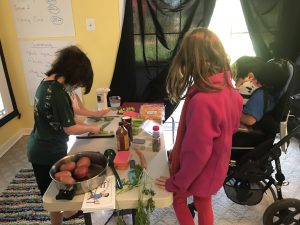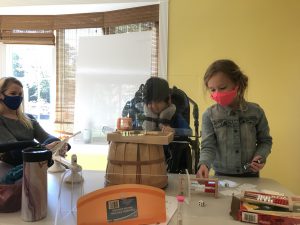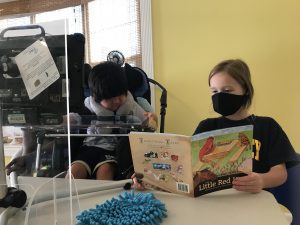 As a part of our schedule in our inclusive pod, we begin each session with a group meeting where we review the day’s message, talk about the date, and review our plans for the day. At the end of this meeting I give each grade level a math challenge based on what we are learning. Right now, the first graders are working on identifying coins, so we’ve been counting coins. The third graders have to count a mix of change, tell me the amount and also identify how much more money they need until they get to one dollar. The first graders have to count one group of coins (pennies, nickels, dimes – not mixed) and tell me how much there is.
As a part of our schedule in our inclusive pod, we begin each session with a group meeting where we review the day’s message, talk about the date, and review our plans for the day. At the end of this meeting I give each grade level a math challenge based on what we are learning. Right now, the first graders are working on identifying coins, so we’ve been counting coins. The third graders have to count a mix of change, tell me the amount and also identify how much more money they need until they get to one dollar. The first graders have to count one group of coins (pennies, nickels, dimes – not mixed) and tell me how much there is.
Creating Units for Our Inclusive Group
 As our inclusive pod goes on I continue to contribute much of the success to the theory that if you plan for the students on the two extremes of your group – those who may need the more intensive support and those who may need extensions, then in the end you will have reached everyone’s needs, including the students falling in the middle.
As our inclusive pod goes on I continue to contribute much of the success to the theory that if you plan for the students on the two extremes of your group – those who may need the more intensive support and those who may need extensions, then in the end you will have reached everyone’s needs, including the students falling in the middle.
One aspect that allows us to do that is our unit planning. Our year long study is around the concept of community – what is a community, who makes up a community, and what does a community do. While this concept seems simple on the outside, each unit we have done has taken us further into answering this question.
Emotional Regulation and Empathy in Our Inclusive Setting
 Last week I only touched the surface of the benefits my own children have gotten from participating in the inclusive pod. Shortly after I wrote, we experienced this moment, which confirmed everything I believe in the value of inclusive settings.
Last week I only touched the surface of the benefits my own children have gotten from participating in the inclusive pod. Shortly after I wrote, we experienced this moment, which confirmed everything I believe in the value of inclusive settings.
Inclusive Guided Reading
 One aspect of our Augmented Learning Study Program is providing small group academic instruction that would be seen in schools. In this time of virtual learning, we want our learners to have an opportunity to learn in groups from each other – as COVID safely as they can.
One aspect of our Augmented Learning Study Program is providing small group academic instruction that would be seen in schools. In this time of virtual learning, we want our learners to have an opportunity to learn in groups from each other – as COVID safely as they can.
One challenge we have worked on is making an inclusive guided reading experience for our first graders who use and do not use devices. As I’ve written about before in teaching Joey to read – it can be extremely tiring for him to read the words on the page and then find them on his device. If we measured his ability to read and comprehend through his output on his device we would continue to see him reading at a beginning kindergarten level. And yet, Joey consistently recognizes many of the words from the dulce list through first grade. He is also able to match sentences from a guided reading text to their picture – demonstrating reading comprehension.
So how do we make that a group activity?
Diving Into Problem Solving – Honoring Wait Time in All Settings
Although we had a great first two weeks in our inclusive Augmentative Learning Study Program (ALPS), we have been able to use those initial weeks to identify areas of our program that need some problem solving. One aspect of our inclusive group that we are going to take awhile to figure out is our timing. How do we both engage all the students while also giving Joey and others who use AAC devices time to find their words?
- 1
- 2
- 3
- …
- 11
- Next Page »


